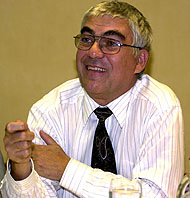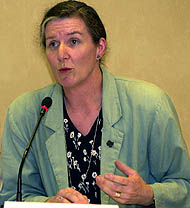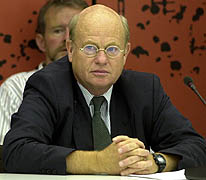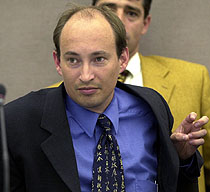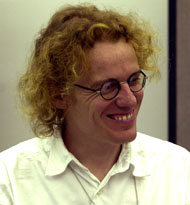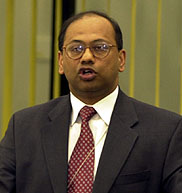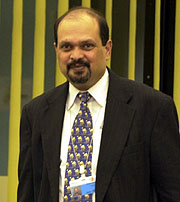|
|
|||||||||||||||||||||||||||||||||||
|
|||||||||||||||||||||||||||||||||||
|
Events convened on Wednesday, 25 July 2001 |
|
Reporting
and review of greenhouse gas inventories from Annex I Parties
Presented by the UNFCCC Secretariat At this event, members of the UNFCCC Secretariat outlined ongoing activities for implementing Decision 3/CP.5 (reporting guidelines on annual GHG inventories) and Decision 6/CP.6 (guidelines for technical review of annual GHG inventories from Annex I Parties). Roberto
Acosta recalled that COP-5 adopted Decisions 3/CP.5 and 6/CP.6,
and established a trial period of 2000-2001 to assess both
guidelines, with a view to revising them at COP-7 and COP-8,
respectively. He explained that the review approach consists
of three stages: an initial check of annual inventories; synthesis
and assessment (S&A) of annual inventories; and expert
review of individual inventories, which includes a desk review,
centralized review and in-country visit review. Acosta noted
that SBSTA-15 may initiate consideration of possible modifications
of the reporting guidelines to be completed by COP-8 rather
than COP-7. He reported that a workshop will be held from
4-8 December 2001, in Bonn, to bring together experts involved
in the preparation and review of inventories to consider methodological
and operational aspects of the guidelines' use. SB-16 may
consider possible modifications of both guidelines with a
view to completing the work by COP-8. Stylianos
Pesmajoglou outlined issues identified in the technical review
of GHG inventories. He reported that, for the year 2000 GHG
submissions, the Secretariat completed initial checks and
status reports of 23 Parties, S&A of the inventories,
desk reviews of three Parties, centralized reviews of six
Parties, and in-country reviews of four Parties. The Secretariat
has also completed initial checks and status reports of 27
Parties for the 2001 GHG submissions. James Grabert provided an overview of the GHG inventory database. He noted that future activities will include reviewing the common reporting format (CRF) software, developing new reporting software, incorporating external statistics used in the review process, revising the web-site interface for GHG data, and improving software tools. Experts involved in the reviews offered insights from their experiences. It was noted that desk reviews provide the opportunity to study national inventory reports (NIRs) and the CRF without the time constraints of in-country visit reviews, although the ability to confer with reviewed Parties could have improved the reviews. Experts noted that the centralized reviews were expensive and time-consuming, and highlighted the need to streamline the process and better prepare review teams. On in-country reviews, experts emphasized the usefulness of the NIR, CRF and S&A reports, and suggested that timely provision of review materials, access to the database, and additional information would have been beneficial. Experts underscored that the Secretariat's support was excellent and crucial to the success of the reviews. More
information: Contact:
|
|
The COOL global dialogue: Options for long-term climate policies and their short-term implications Presented by the Free University Amsterdam in cooperation with the National Institute of Public Health and the Environment (RIVM)
Bert Metz, RIVM, stated that the aim of the Climate OptiOns for the Long term (COOL) project is to investigate options for a long-term climate policy strategy in the Netherlands and within European and global contexts. He explained that COOL uses a back-casting approach, focuses on the long term (2050), and entails drastic emissions reductions. Metz showed that stabilizing CO2 concentrations at 450 ppm is technically feasible at relatively low cost through, inter alia, shifting to renewables, using CO2-neutral transportation fuels, and practicing energy efficiency. He demonstrated that stabilization at 450 ppm will require emissions reductions of 15-25 percent globally by 2050, with a peaking of global CO2 levels within the next two decades. Stressing the inertia of natural and human systems, Metz emphasized the need for early action. He concluded that crucial actions for the next decade include: ratifying and implementing the Kyoto Protocol; discussing an equitable regime for future differentiation of commitments; investing in cleaner technologies; raising public awareness; and incorporating climate protection goals into sustainable development strategies that aim to transition to low carbon energy systems.
Atiq Rahman, Bangladesh Centre for Advanced Studies, stated that the world faces considerable risks if immediate action is not taken to prevent climate change. He expressed disappointment with negotiators who argue that drastic emissions reductions cannot be achieved, and highlighted the need to shift from a "can't-be-done" to a "can-be-done" mindset. Discussion: Participants discussed, inter alia: costs of non-action; the need to reduce atmospheric CO2 concentrations below 450 ppm; the carbon intensity approach; the potential for hydrogen power; and the importance of immediate emissions reductions. More
information: Contact: Please visit the UNFCCC's "On Demand" webcast page for RealVideo coverage of this event |
|
A new IMAGE on future emissions and climate impacts Presented by the National Institute for Public Health and the Environment (RIVM)
Detlef
van Vuuren, RIVM, noted that the IMAGE model illustrates possible
global development patterns over the next century, and indicates
the climate change impacts that will result in the absence
of strong climate change policy. He added that the IMAGE framework
is based on a set of linked models. From his analysis of the
IMAGE model, van Vuuren highlighted that: GHG emissions are
related to developments and policies in several sectors; in
each scenario, GHG emissions will increase over the next ten
to fifty years, and the Kyoto targets will not be met; after
2050, emissions could increase five-fold, or decrease by half,
depending upon the scenario; substantial co-benefits exist
between sustainable development and climate change policy;
and needs and opportunities for climate change mitigation
differ across countries.
Bart
Strengers, RIVM, discussed the relative importance of land-use
emissions in the SRES. He stated that, in the absence of adequate
climate policies, each scenario results in high levels of
emissions. From his IMAGE model analysis, Strengers concluded
that: land-use emissions are important; climate change will
have negative impacts on ecosystems and mixed impacts on agricultural
systems; despite many uncertainties, uptake by the biosphere
and oceans plays an important role; and stronger climate policy
is necessary.
More information: Contact: |
|
The CDM-Assist programme at the World Bank Presented by the World Bank and the CDM-Assist programme
More
information: Contact:
|
|
Standardizing baselines for electricity, energy demand, heavy industry and transport projects Presented by UNEP, OECD and the International Energy Agency (IEA)
Jane
Ellis, OECD, explained that the workshop's aims were to: bring
together a wide range of experts from Annex I and non-Annex
I countries; outline issues relevant in baseline standardization
for the electricity generation, energy efficiency, heavy industry
and transport sectors; and develop recommendations on baseline
methodologies in these sectors. She emphasized that, when
standardizing baselines, one must determine clear project
categories, geographical boundaries, the gases and sources
to be included, standard units for baselines, and the crediting
lifetime. Paulo
Manso, Costa Rican Office on JI, noted that the workshop's
findings on standardizing baselines for electricity emphasized
the need to distinguish between grid and off-grid projects,
distinguish between new projects and retrofits, and fast-track
small projects. The workshop recommended that: grams of CO2
per kilowatt-hour be the baseline unit; all direct on-site
GHG emissions be counted; and baseline lifetime be longer
for small projects with extended lifetimes.
Martina
Bosi, IEA, noted that, on baselines for energy demand, workshop
participants recommended that baselines be calculated using
energy use baselines and then translated into GHG emissions
with relevant standard electricity baseline values. On baseline
standardization, they concluded that calculation formulae
can be standardized for different energy efficiency project
types, and some parameters may be standardized, while others
may require project-specific data. Participants also found
that the baseline lifetime should be shorter than the technical
lifetime, and baselines should only be updated for new projects.
Harald Winkler, University of Cape Town's Energy and Development Research Centre, outlined the workshop's conclusions on standardizing baselines for the cement, iron and steel industries. The workshop recommended: including "significant" direct and indirect emissions sources in the baseline; distinguishing between different production routes and potentially between different fuels; and using rate-based baselines. Regarding crediting lifetimes, they discussed offering investors a choice between a shorter lifetime with a fixed baseline or a longer lifetime that can be revised, and recommended that a plant operate for a minimum of five years before any baseline revisions. Fanny Missfeldt, UNEP Collaborating Centre on Energy and Environment, said the workshop found that, in transport projects, rebound or cross-sectoral effects may be significant and should be accounted for in a standardized manner. To calculate baselines in the transport sector, the type of project must be identified, direct emissions calculated, and significant rebound effects attributed. The workshop identified challenges for standardizing baselines in transport, including: data availability and collection methods; appropriate boundary definition; identification and quantification of offsetting behavior; and the development of unit sizes and unit emissions reductions as building blocks for aggregating larger projects. More
information: Contact: |
|
|
|
| The Earth Negotiations Bulletin (ENB) on the side is a special publication of the International Institute for Sustainable Development (IISD) in cooperation with the United Nations Framework Convention on Climate Change (UNFCCC) Secretariat. The Editor of ENB on the side is Kira Schmidt <kira@iisd.org>. This issue has been written by Emily Boyd <emily@iisd.org>, Fiona Koza <fiona@iisd.org> and Kira Schmidt <kira@iisd.org>. The Digital Editors are Andrei Henry <andrei@iisd.org> and Kenneth Tong <ken@iisd.org>. Photos by Andrei Henry <andrei@iisd.org> and Leila Mead <leila@iisd.org>. Funding for publication of ENB on the side at COP-6 Part II is provided by the UNFCCC Secretariat. The opinions expressed in ENB on the side are those of the authors and do not necessarily reflect the views of IISD and funders. Excerpts from ENB on the side may be used in non-commercial publications only and only with appropriate academic citation. For permission to use this material in commercial publications, contact the Managing Editor at <kimo@iisd.org>. Electronic versions of these issues of ENB on the side from COP-6 Part II can be found on the Linkages WWW server at http://enb.iisd.org/climate/cop6bis/enbots/. | |
|
|
| © 2001, IISD. All rights reserved. |
|



